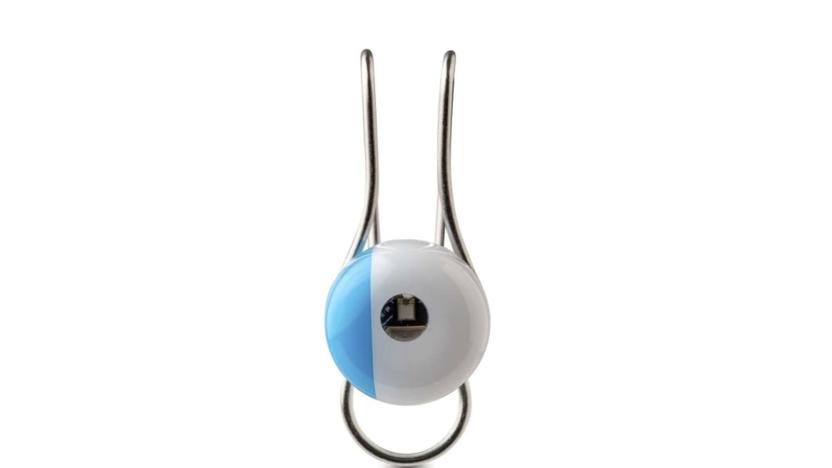JohnRogers
Latest

L’Oreal and John Rogers built a sticker to measure skin pH
The fruitful partnership between cosmetics giant L'Oreal and wearable pioneer Professor John Rogers has produced a new sensor for 2019. My Skin Track pH by La Roche-Posay is a wearable sensor, smaller than a Band Aid, that monitors your skin's hydration levels.

L'Oreal's wearable sensor tracks UV, pollen and pollution
L'Oreal isn't a brand you'd usually associate with medical technology, but over the past few years it's been making major inroads in skin protection innovation. There was My UV Patch, designed to inform wearers how their skin was being affected by the sun, and then UV Sense, a thumbnail-sized smart device that helped monitor sun exposure. Now, it's launching a battery-free wearable electronic that tracks your exposure to UV, pollution, pollen and humidity.

L’Oreal and John Rogers built a thumbnail-sized UV sensor
L'Oreal is not a name that you'd normally associate with CES, but the cosmetics giant is now a regular exhibitor at the show. This year, the company is demonstrating a thumbnail-worn smart device that's less than two millimeters thick. UV Sense is a battery-free electronic sensor that's designed to monitor your sun exposure and, when coupled with an NFC-enabled smartphone, help limit your skin cancer risk.

The first generation of real wearable tattoos are here
Whenever people talk about the technology of the future, someone will always bring up "tattoo-style" diagnostic technology. MC10, a firm that's emerged out of research by medical wearables pioneer John Rogers, has now been able to make devices like that a reality. The firm is announcing two new products here at CES, one designed for use in research environments as well as a consumer-facing version for the mass market. The first is the BioStamp Research Connect, a flexible wearable sensor that'll adhere to your skin and keep an eye on your vitals.

Researchers print biometric sensors directly on skin, make wearable health monitors more durable
MC10 might be best known for its wearable electronics aimed at athletes, but the company also makes a medical diagnostic sticker called a biostamp. Its creator (and MC10 co-founder), John Rogers has refined that design so that it's no longer an elastomer sticker -- now he can apply the biostamp's thin, stretchy electronics directly on human skin, and bond it with commercially available spray-on bandage material. By losing the elastomer backing of the original biostamp and applying the circuits directly to the skin, Rogers and his team at the University of Illinois were able to shave the device's thickness to 1/30th of the (already quite thin) biostamp. That super thin profile means it conforms even better to the contours of human hide and makes it shower- and swim-proof during the two weeks it lasts before being naturally exfoliated with your skin. For those unfamiliar with what the biostamp does, it's a mesh of circuits and sensors that can record electrophysiological data like skin temperature and hydration state of the wearer. The new biostamp won't be in your doctor's tool box any time soon, however, as Rogers and his team are still refining the wireless power and communication technologies it leverages. Of course, once those problems are solved, there's a good chance we'll see MC10 turning it into a commercial product.

John Rogers returns with a silicon-silk circuit that dissolves inside your body
While you'd be forgiven for not knowing who John Rogers is, he's certainly graced these pages more than once. He's the research chief at the University of Illinois that's previously broken new ground in the world of invisibility cloaks and wearable technology. This time, his team has cooked up a silicon, magnesium, magnesium oxide and silk circuit that's designed to dissolve in the body in the same way that absorbable sutures are used in minor surgeries. It's thought that the tech could eventually be used to implant monitors that never need removal, reducing invasive medical procedures, or even build devices that eventually turn into compost rather than E-waste -- although we're not sure we'd appreciate our smartphone doing the same thing when we're making calls in the rain. [Image Credit: Fiorenzo Omenetto / Science]

EES packs circuits into temporary tattoos, makes medical diagnostics fashionable
Flexible circuit pioneer John Rogers and his team are at it again. This time he's developing a wearable, ultra-thin circuit that attaches to your skin just like a temporary tattoo. The Epidermal Electronic System (EES) consists of circuits which could contain electrodes capable of measuring brain, heart and muscle activity in the same way an EEG does now, transmitting this data wirelessly to your doctor. Because it's flexible and bonds to the skin, it can be worn for extended periods, unlike traditional diagnostic pads used in hospitals today. In the lab, the devices were solar-powered with embedded photovoltaic cells -- heavier duty circuits would require inductive charging to be practical. Rogers' team also looked into the tech acting as a game controller (they wired it up to someone's throat and played Sokoban with voice commands, still managing to yield a 90 percent accuracy rate), but it's some way off from replacing your SIXAXIS. One of the problems encountered concerned RF communication -- perhaps they should get on the horn to their friends in Oregon and build those fashionable diagnostic pants we're eagerly waiting for.

Metamaterial printing method inches us closer to invisibility cloaks
In theory, metamaterials are all kinds of awesome -- they can boost antenna strength, focus lasers, and create invisibility cloaks. But, they've been limited to day dreams lab experiments because producing the light-interfering materials in any practical quantity has been difficult and time consuming. John Rogers, a professor at the University of Illinois has figured out a way to print a layered, nano-scale mesh that bends near-infrared light in much larger amounts than previously possible. The new method, based around a plastic stamp, has been used to create sheets of metamaterial measuring a few square inches, but Rogers is confident he can scale it up to several feet. Who knows, by the time the second installment of The Deathly Hallows hits theaters in July you could get the best Harry Potter costume -- one that lets you sneak in without shelling out $13. [Thanks, Plum G.]

Reebok sets sights on flexible computing sportswear, partners with startup team
Science has prototyped flexible versions of just about everything a ever-loving geek needs: displays, memory, batteries, LEDs, speakers and an input device or three. Now, Reebok's looking to put some of that computing power up our sleeves. The apparel manufacturer's teamed up with MC10 -- a startup founded by our old friend John Rogers, who helped pioneer the field -- with the intent to build "conformable electronics" into high-performance clothing for athletes over the next couple of years. Though the company told MIT Technology Review the devices typically consist of thin silicon strips printed onto flexible materials, and that they might they might measure metabolism and performance using embedded sensors, hard details are few -- the only thing we know for sure is that a flexible tech scientist just scored a partnership with a major company, and we're hopeful they'll make something neat. PR after the break.

Flexible, implantable LEDs look set to start a new body modification craze
LED lights are cool, you're cool, why not combine the two, right? We doubt that's quite the reasoning that led to this international research project, but it's certainly an appealing way to look at it. Our old buddy John Rogers from the University of Illinois at Urbana-Champaign has headed up a research team with participants from the US, China, Korea, and Singapore, who have together produced and demonstrated a new flexible and implantable LED array. Bettering previous efforts at inserting lights under the human skin, this approach allows for stretching and twisting by as much as 75 percent, while the whole substrate is encased in thin silicon rubber making it waterproof. Basically, it's a green light to subdermal illumination, which could aid such things as monitoring the healing of wounds, activating light-sensitive drug delivery, spectroscopy, and even robotics. By which we're guessing they mean our robot overlords will be able to color-code us more easily. Yeah, that must be it.

TNT's Leverage is the latest stretch-o-vision victim
Anyone watching Tuesday's episode of Leverage (The Wedding Job) probably quickly noticed that instead of the crisp 720p image we've become accustomed to, it was being delivered in TNT's disorienting stretch format, taking a 4x3 picture and adjusting whatever it thought we weren't looking at to fill the gaps. Why TNT still uses this at all in 2009 is beyond us, but we got in contact with Executive Producer (and blogger) John Rogers to find out what happened. We still don't know the details, but he let us know via email that it was a simple case of someone transmitting the wrong version, so we should be able to look forward to properly formatted TV for the rest of its run (let it be known: if someone screws up The Closer, there will be consequences & repercussions.) Read - AVS Forum Read - Kung Fu Monkey

Stretchy silicon circuits wrap around complex shapes, like your wife
The first "completely integrated, extremely bendable circuit" was just demonstrated to the world. The team behind the research is led by John Rogers of the University of Illinois at Urbana-Champaign. The process bonds circuit sheets measuring just 1.5 micrometers (50 times thinner than human hair) to a piece of pre-stretched rubber. That allows the circuits to buckle like an accordion when pulled or twisted without losing their electrical properties. Unfortunately, the materials used thus far are not compatible with human tissue. In other words, no X-ray vision implant for you. X-ray contacts perhaps... quantum-computers now, please Mr. Scientists? Watch a circuit buckle in the video after the break.[Via BBC, thanks YoJIMbo]




